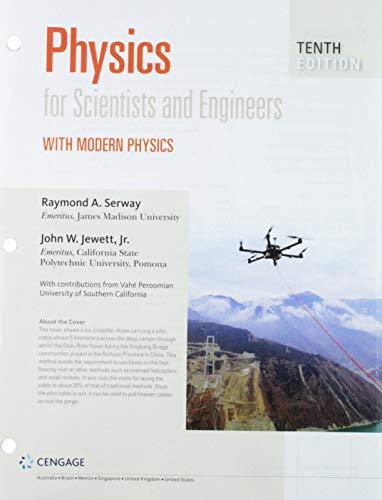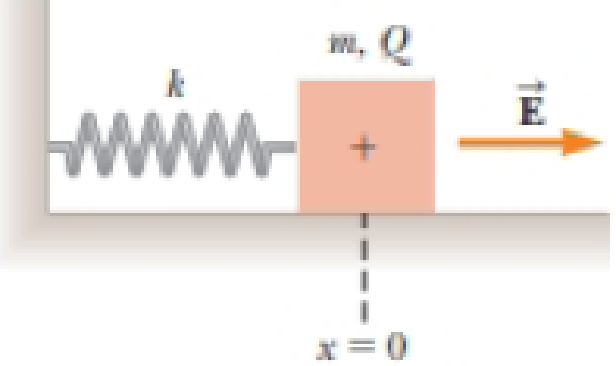
Concept explainers
Review. A block having mass m and charge + Q is connected to an insulating spring having a force constant k. The block lies on a frictionless, insulating, horizontal track, and the system is immersed in a uniform electric field of magnitude E directed as shown in Figure P24.6. The block is released from rest when the spring is unstretched (at x = 0). We wish to show that the ensuing motion of the block is simple harmonic. (a) Consider the system of the block, the spring, and the electric field. Is this system isolated or nonisolated? (b) What kinds of potential energy exist within this system? (c) Call the initial configuration of the system that existing just as the block is released from rest. The final configuration is when the block momentarily comes to rest again. What is the value of x when the block comes to rest momentarily? (d) At some value of x we will call x = x0, the block has zero net force on it. What analysis model describes the particle in this situation? (c) What is the value of x0? (f) Define a new coordinate system x′ such that x′ = x − x0. Show that x′ satisfies a differential equation for
Figure P24.6

(a)
Whether the system is isolated or non-isolated.
Answer to Problem 6P
The system is non-isolated.
Explanation of Solution
Given info: The mass of the block is
The system of the block with a spring is isolated system but when the system of the block with a spring is placed in a electric or magnetic field then it experiences an external force that makes the system non-isolated.
Conclusion:
Therefore, the system is non-isolated.
(b)
The kinds of potential energy exist in the system.
Answer to Problem 6P
The kinds of potential energy exist in the system are elastic potential energy and electrostatic potential energy.
Explanation of Solution
Given info: The mass of the block is
There are two kinds of potential energy exist in the system one is elastic potential energy and other is electrostatic potential energy.
The formula to calculate the elastic potential energy is,
Here,
The formula to calculate the electrostatic potential energy is,
Here,
The formula to calculate electrostatic force is,
Here,
Substitute
Conclusion:
Therefore, the kinds of potential energy exist in the system are elastic potential energy and electrostatic potential energy.
(c)
The value of
Answer to Problem 6P
The value of
Explanation of Solution
Given info: The mass of the block is
The formula to calculate the elastic potential energy is,
Here,
The formula to calculate the electrostatic potential energy is,
Here,
The formula to calculate electrostatic force is,
Here,
Substitute
Equate the formula (1) and (2) as,
Conclusion:
Therefore, the value of
(d)
The analysis model that describes particle in this situation.
Answer to Problem 6P
The analysis model that describes the particle in this situation is in equilibrium.
Explanation of Solution
Given info: The mass of the block is
The above statement is explained as the net force acting on the block is zero at some value of
Conclusion:
Therefore, the particle in this situation is in equilibrium.
(e)
The value of
Answer to Problem 6P
The value of
Explanation of Solution
Given info: The mass of the block is
The formula to calculate the spring force is,
Here,
The formula to calculate electric force is,
Here,
The net force is zero so it is expressed as,
Here,
Rearrange the above expression to find
Conclusion:
Therefore, the value of
(f)
To show: The coordinate
Answer to Problem 6P
Thus, the coordinate
Explanation of Solution
The mass of the block is
Given info:
From part (e), the value of
The formula to calculate the force equation is,
Here,
The formula to calculate the acceleration is,
Here,
The summation of the force is,
Here,
The new coordinate is,

Substitute
Substitute
This is the required equation of S.H.M.
Conclusion:
Therefore, the coordinate
(g)
The period of the simple harmonic motion.
Answer to Problem 6P
The period of the simple harmonic motion is
Explanation of Solution
Given info: The mass of the block is
From part (f), the equation for the S.H.M is,
The general equation of S.H.M is,
Here,
Compare the equation (4) and (5) as,
The formula to calculate the time period is,
Here,
Substitute
Conclusion:
Therefore, the period of the simple harmonic motion is
(h)
The time period depend on the electric field magnitude or not.
Answer to Problem 6P
The time period does not depend on the electric field magnitude.
Explanation of Solution
Given info: The mass of the block is
From part (g),the time period is,
In the above formula, there is no term that signifies electric field magnitude. So the time period is independent of electric field magnitude.
Conclusion:
Therefore, the time period does not depend on the electric field magnitude.
Want to see more full solutions like this?
Chapter 24 Solutions
Bundle: Physics For Scientists And Engineers With Modern Physics, Loose-leaf Version, 10th + Webassign Printed Access Card For Serway/jewett's Physics For Scientists And Engineers, 10th, Single-term
Additional Science Textbook Solutions
College Physics: A Strategic Approach (3rd Edition)
Microbiology Fundamentals: A Clinical Approach
Fundamentals Of Thermodynamics
MARINE BIOLOGY
Campbell Essential Biology (7th Edition)
Cosmic Perspective Fundamentals
- The 10-lb weight is supported by the cord AC and roller and by the spring that has a stiffness of k = 10 lb/in. and an unstretched length of 12 in. as shown in. Part A Determine the distance d to maintain equilibrium. Express your answer in inches to three significant figures. 節 ΕΠΙ ΑΣΦ d = *k J vec 5 t 0 ? d C A in. 12 in. Barrow_forwardThe members of a truss are connected to the gusset plate as shown in . The forces are concurrent at point O. Take = 90° and T₁ = 7.5 kN. Part A Determine the magnitude of F for equilibrium. Express your answer to three significant figures and include the appropriate units. F = Value Submit Request Answer Part B 0 ? Units Determine the magnitude of T2 for equilibrium. Express your answer to three significant figures and include the appropriate units. ? T₂ = Value Units T₁ Carrow_forwardpls help on botharrow_forward
- pls helparrow_forwardpls helparrow_forward6. 6. There are 1000 turns on the primary side of a transformer and 200 turns on thesecondary side. If 440 V are supplied to the primary winding, what is the voltageinduced in the secondary winding? Is this a step-up or step-down transformer? 7. 80 V are supplied to the primary winding of a transformer that has 50 turns. If thesecondary side has 50,000 turns, what is the voltage induced on the secondary side?Is this a step-up or step-down transformer? 8. There are 50 turns on the primary side of a transformer and 500 turns on thesecondary side. The current through the primary winding is 6 A. What is the turnsratio of this transformer? What is the current, in milliamps, through the secondarywinding?9. The current through the primary winding on a transformer is 5 A. There are 1000turns on the primary winding and 20 turns on the secondary winding. What is theturns ratio of this transformer? What is the current, in amps, through the secondarywinding?arrow_forward
- No chatgpt plsarrow_forwardWhat is the current, in amps, across a conductor that has a resistance of10 Ω and a voltage of 20 V? 2. A conductor draws a current of 100 A and a resistance of 5 Ω. What is thevoltageacross the conductor? 3. What is the resistance, in ohm’s, of a conductor that has a voltage of 80 kVand acurrent of 200 mA? 4. An x-ray imaging system that draws a current of 90 A is supplied with 220V. What is the power consumed? 5. An x-ray is produced using 800 mA and 100 kV. What is the powerconsumed in kilowatts?arrow_forwardՍՈՈՒ XVirginia Western Community Coll x P Course Home X + astering.pearson.com/?courseld=13289599#/ Figure y (mm) x=0x = 0.0900 m All ✓ Correct For either the time for one full cycle is 0.040 s; this is the period. Part C - ON You are told that the two points x = 0 and x = 0.0900 m are within one wavelength of each other. If the wave is moving in the +x-direction, determine the wavelength. Express your answer to two significant figures and include the appropriate units. 0 t(s) λ = Value m 0.01 0.03 0.05 0.07 Copyright © 2025 Pearson Education Inc. All rights reserved. 日 F3 F4 F5 1775 % F6 F7 B F8 Submit Previous Answers Request Answer ? × Incorrect; Try Again; 3 attempts remaining | Terms of Use | Privacy Policy | Permissions | Contact Us | Cookie Settings 28°F Clear 4 9:23 PM 1/20/2025 F9 prt sc F10 home F11 end F12 insert delete 6 7 29 & * ( 8 9 0 t = back Οarrow_forward
- Part C Find the height yi from which the rock was launched. Express your answer in meters to three significant figures. Learning Goal: To practice Problem-Solving Strategy 4.1 for projectile motion problems. A rock thrown with speed 12.0 m/s and launch angle 30.0 ∘ (above the horizontal) travels a horizontal distance of d = 19.0 m before hitting the ground. From what height was the rock thrown? Use the value g = 9.800 m/s2 for the free-fall acceleration. PROBLEM-SOLVING STRATEGY 4.1 Projectile motion problems MODEL: Is it reasonable to ignore air resistance? If so, use the projectile motion model. VISUALIZE: Establish a coordinate system with the x-axis horizontal and the y-axis vertical. Define symbols and identify what the problem is trying to find. For a launch at angle θ, the initial velocity components are vix=v0cosθ and viy=v0sinθ. SOLVE: The acceleration is known: ax=0 and ay=−g. Thus, the problem becomes one of…arrow_forwardPhys 25arrow_forwardPhys 22arrow_forward
 Physics for Scientists and Engineers with Modern ...PhysicsISBN:9781337553292Author:Raymond A. Serway, John W. JewettPublisher:Cengage Learning
Physics for Scientists and Engineers with Modern ...PhysicsISBN:9781337553292Author:Raymond A. Serway, John W. JewettPublisher:Cengage Learning Physics for Scientists and Engineers: Foundations...PhysicsISBN:9781133939146Author:Katz, Debora M.Publisher:Cengage Learning
Physics for Scientists and Engineers: Foundations...PhysicsISBN:9781133939146Author:Katz, Debora M.Publisher:Cengage Learning Principles of Physics: A Calculus-Based TextPhysicsISBN:9781133104261Author:Raymond A. Serway, John W. JewettPublisher:Cengage Learning
Principles of Physics: A Calculus-Based TextPhysicsISBN:9781133104261Author:Raymond A. Serway, John W. JewettPublisher:Cengage Learning
 Physics for Scientists and Engineers, Technology ...PhysicsISBN:9781305116399Author:Raymond A. Serway, John W. JewettPublisher:Cengage Learning
Physics for Scientists and Engineers, Technology ...PhysicsISBN:9781305116399Author:Raymond A. Serway, John W. JewettPublisher:Cengage Learning Physics for Scientists and EngineersPhysicsISBN:9781337553278Author:Raymond A. Serway, John W. JewettPublisher:Cengage Learning
Physics for Scientists and EngineersPhysicsISBN:9781337553278Author:Raymond A. Serway, John W. JewettPublisher:Cengage Learning





